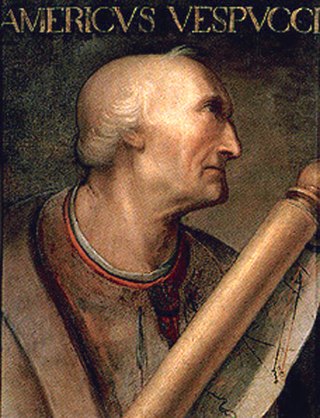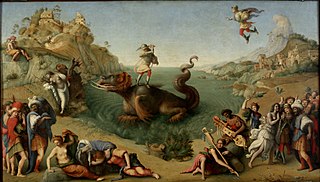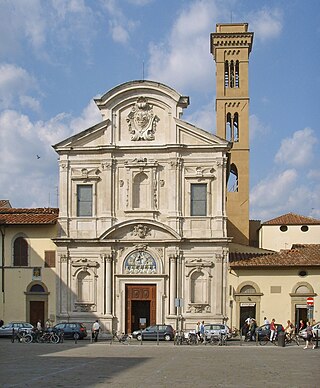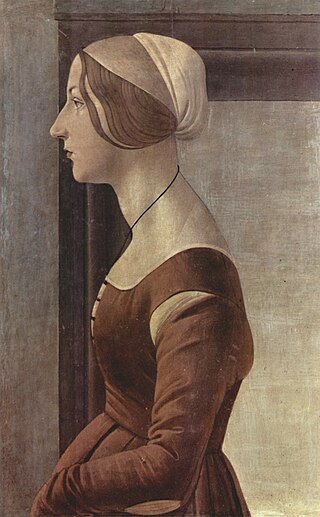See also
- 29706 Simonetta, a main-belt asteroid
Simonetta is an Italian surname and female given. Notable people with the name include:
Amalric or Amalaric is a personal name derived from the tribal name Amal and ric meaning "ruler, prince".

Amerigo Vespucci was an Italian explorer and navigator from the Republic of Florence, from whose name the term "America" is derived.

Alessandro di Mariano di Vanni Filipepi, better known as Sandro Botticelli or simply Botticelli, was an Italian painter of the Early Renaissance. Botticelli's posthumous reputation suffered until the late 19th century, when he was rediscovered by the Pre-Raphaelites who stimulated a reappraisal of his work. Since then, his paintings have been seen to represent the linear grace of late Italian Gothic and some Early Renaissance painting, even though they date from the latter half of the Italian Renaissance period.

Piero di Cosimo, also known as Piero di Lorenzo, was an Italian painter of the Renaissance.

Giuliano de' Medici was the second son of Piero de' Medici and Lucrezia Tornabuoni. As co-ruler of Florence, with his brother Lorenzo the Magnificent, he complemented his brother's image as the "patron of the arts" with his own image as the handsome, sporting "golden boy." He was killed in a plot known as the Pazzi conspiracy.

The Amerigo Vespucci is a tall ship of the Italian Navy named after the explorer Amerigo Vespucci. Its home port is La Spezia, Italy, and it is in use as a training ship.
Vespucci may refer to:

The term "New World" is used to describe the majority of lands of Earth's Western Hemisphere, particularly the Americas. The term gained prominence in the early 16th century during Europe's Age of Discovery, after Italian explorer Amerigo Vespucci published the Latin-language pamphlet Mundus Novus, presenting his conclusion that these lands constitute a new continent. This realization expanded the geographical horizon of earlier European geographers, who had thought that the world only included Afro-Eurasian lands. Africa, Asia and Europe thus became collectively called the "Old World" of the Eastern Hemisphere, while the Americas were then referred to as "the fourth part of the world", or the "New World".

Portrait of Simonetta Vespucci is an oil on canvas painting by the Italian Renaissance painter Piero di Cosimo, dating from about 1480 or 1490. It is in the Musée Condé in Chantilly, France.

Simonetta Vespucci, nicknamed la bella Simonetta, was an Italian noblewoman from Genoa, the wife of Marco Vespucci of Florence and the cousin-in-law of Amerigo Vespucci. She was known as the greatest beauty of her age in Italy, and was allegedly the model for many paintings by Sandro Botticelli, Piero di Cosimo, and other Florentine painters. Some art historians have taken issue with these attributions, which the Victorian critic John Ruskin has been blamed for promulgating.

I Medici is an opera in four acts composed by Ruggero Leoncavallo, with a libretto by the composer. Set in Renaissance Florence at the court of Lorenzo de' Medici, it was intended as the first part of a planned but unfinished trilogy called Crepusculum. The opera premiered on 6 November 1893 at the Teatro Dal Verme in Milan.

The chiesa di San Salvatore di Ognissanti, or more simply chiesa di Ognissanti, is a Franciscan church located on the piazza of the same name in central Florence, region of Tuscany, Italy. Founded by the lay order of the Umiliati, the church was dedicated to all the saints and martyrs, known and unknown.
Cattaneo (Italian:[katˈtaːneo] is an Italian surname.

Jacopo III Appiano, VI Lord of Piombino was an Italian nobleman.

Portrait of a Young Woman is a painting which is commonly believed to be by the Italian Renaissance painter Sandro Botticelli, executed between 1480 and 1485. Others attribute authorship to Jacopo da Sellaio. The woman is shown in profile but with her bust turned in three-quarter view to reveal a cameo medallion she is wearing around her neck. The medallion is a copy in reverse of "Nero's Seal", a famous antique carnelian representing Apollo and Marsyas, which belonged to Lorenzo de' Medici.

Venus and Mars is a panel painting of about 1485 by the Italian Renaissance painter Sandro Botticelli. It shows the Roman gods Venus, goddess of love, and Mars, god of war, in an allegory of beauty and valour. The youthful and voluptuous couple recline in a forest setting, surrounded by playful baby satyrs.

Primavera, is a large panel painting in tempera paint by the Italian Renaissance painter Sandro Botticelli made in the late 1470s or early 1480s. It has been described as "one of the most written about, and most controversial paintings in the world", and also "one of the most popular paintings in Western art".

Fioretta Gorini was the mistress of Giuliano de' Medici and the probable mother of Giulio de' Medici, the future Pope Clement VII. Gorini was the daughter of a professor, Antonio Gorini. Her actual name was Antonia or Antonietta, while Fioretta was a nickname given to her.

The House of Cattaneo is a Genoese noble family, that had an important role in the history of the Republic of Genoa, giving five Doges to the Republic.

Semiramide Appiano was an Italian noblewoman, daughter of the Lord of Piombino Jacopo III Appiano and wife of Lorenzo di Pierfrancesco de' Medici. She was the niece of the famous Simonetta Vespucci, Botticelli's muse.